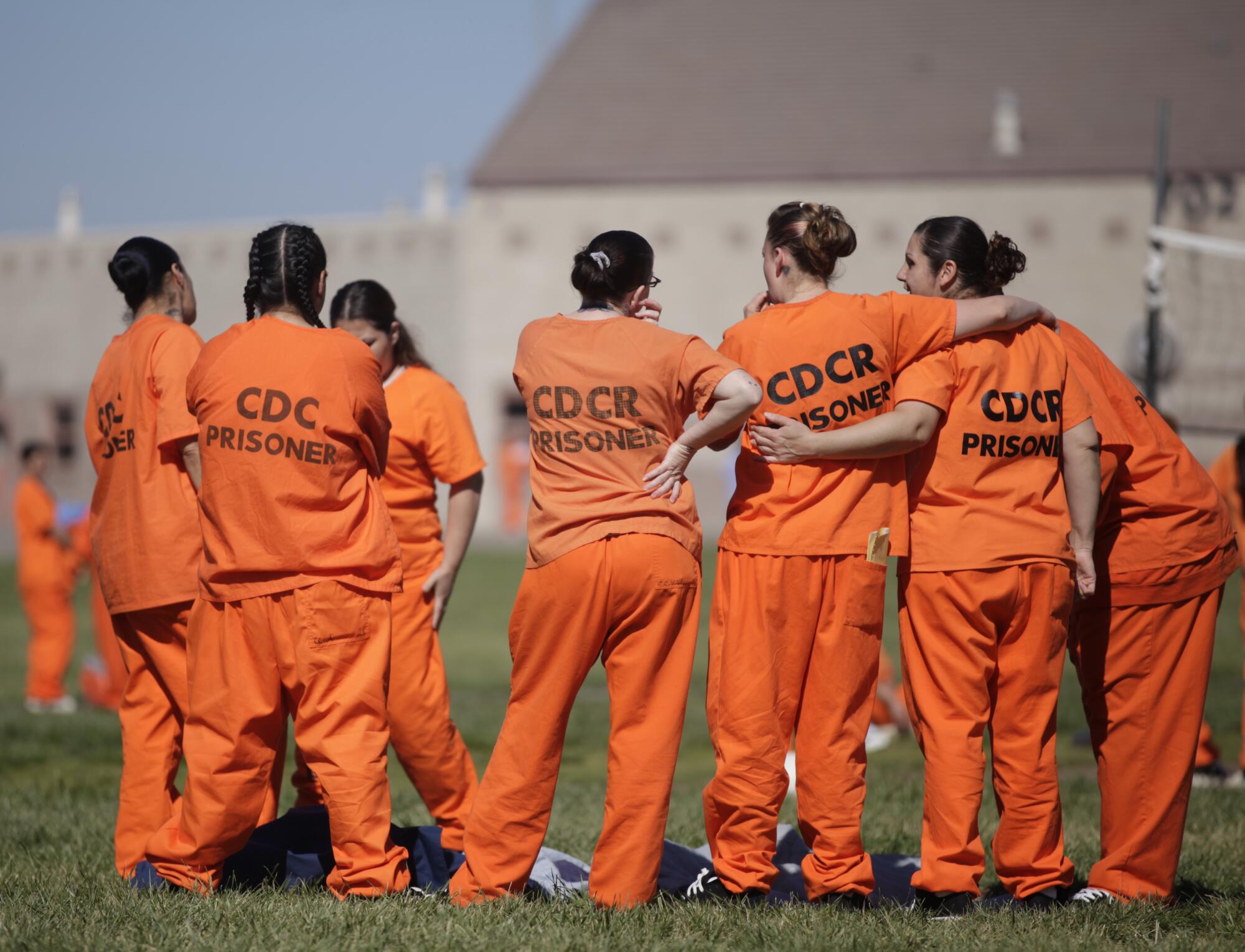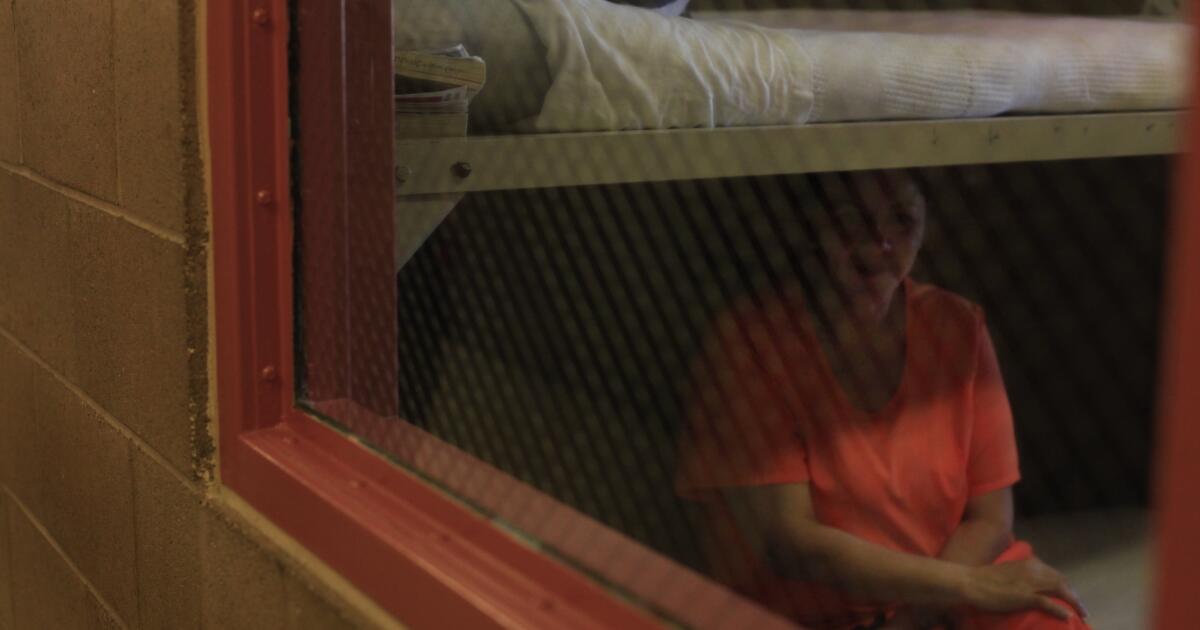The potential heat-related death of a prison inmate in California’s Central Valley this week is focusing renewed attention on conditions within correctional institutions as extreme heat, wildfire smoke and flooding pose increasing threats to incarcerated people.
Though extreme heat endangers residents throughout the state, experts say California’s prisons are uniquely unprepared for climate change because of a variety of factors, including their remote locations, aging infrastructure and overcrowding.
Many facilities are not equipped with central air conditioning, updated ventilation, shade structures or backup generators to power fans and other cooling devices during outages, according to a 2023 report by the UCLA Luskin School of Public Affairs and the Ella Baker Center for Human Rights.
What’s more, the state’s 94,000 incarcerated people are distinctly vulnerable to climate hazards because they are entirely reliant upon the California Department of Corrections and Rehabilitation for preparedness and response.
“As these climate hazards become more common in these areas, it’s important that the system has a plan or strategies in place to make sure that these folks are safe,” said Guadalupe Gutierrez, one of the report’s authors. “No one can outrun a wildfire, out-swim a flood or escape a heat wave — least of all if you’re inside a prison.”
State officials have provided few details about the person who died this week, identified as Adrienne M. Boulware, an inmate at the Central California Women’s Facility in Chowchilla.
The California Coalition for Women Prisoners, an advocacy group, reported Monday that she became incoherent and unresponsive while suffering from heat exhaustion as temperatures in the area soared to 113 degrees. CDCR, however, said her cause of death appears to be from an ongoing medical condition, and that she died two days after being transported to an outside medical facility for treatment.
The agency is “closely monitoring the current heat wave and is coordinating with our state partners and the leadership in each of the state’s 32 prisons to ensure there are appropriate resources and response,” CDCR spokeswoman Mary Xjimenez said. “We are paying special attention to medically vulnerable incarcerated people and will be providing additional water, ice, cooling areas, and information to our staff and incarcerated population on ways to prevent heat-related illnesses throughout this heat wave.”
Dangerous heat inside prisons is not uncommon.
One incarcerated person at the California Correctional Institution in Kern County told The Times that he’s been using a small fan and a wet rag to keep his body temperature down, but that the rag dries quickly in the hot, arid air. His shower has only one knob — hot water — which offered no relief as temperatures in the Tehachapi area soared to 102 degrees this week.
“The last few days I’ve pretty much laid on top of my rag,” said the 32-year-old, who asked not to be identified for fear of retaliation. “I took off my socks. I took off everything, pretty much, except my boxers, and I just kept falling asleep because it was just so hot. I was just getting so lazy, and I was getting headaches and super thirsty.”
But the Tehachapi facility is only one of several state institutions that are ill-equipped for climate change. The report identified eight California prisons that are particularly vulnerable to extreme heat — all of which are in Kern, Imperial, Riverside, Los Angeles and San Diego counties.
“Especially in the Central Valley and Southern California, they are located in areas that are like an oven,” said Ashley Chambers, a spokesperson for the Ella Baker Center, an Oakland nonprofit. “And when temperatures reach 100 degrees and higher, those prison walls are not created to keep heat out. They’re not created to keep wildfire smoke out.”
Indeed, state facilities are also susceptible to other climate hazards, such as the California Institution for Women and the California Institution for Men in San Bernardino County, which were among those found to be most vulnerable to wildfires and their smoke. The report did not include federal prisons, county jails or other local holding facilities.
The California State Prison in Corcoran, Kings County, was among those found to be most vulnerable to floods — and in fact did come close to inundation during record rains last year.
“The climate crisis impacts all of us, including people that are inside our California state prisons,” Chambers said.
But extreme heat continues to pose the largest threat. A survey of nearly 600 incarcerated people found that the majority of respondents did not feel prepared for the hazard despite the fact that more than half of them, 372 people, had experienced it, according to the report.
Eighty-seven percent of respondents said the yard they use most frequently has no shade covering, while 60% said they have never had access to air-conditioned rooms during extremely hot days. About half, 47%, said they never had increased access to showers during heat events.
The respondents advocated for improvements that they said would help, including infrastructure changes such as the addition of air conditioners, ventilation, shade and other cooling systems, as well as better preparedness and training among staff.
CDCR’s 2023 annual report outlines some projects aimed at addressing those concerns, including heat and ventilation improvements in several facilities. However, many of the plans have timelines of five to 10 years.
In the meantime, daily maximum temperatures are already rising and are expected to keep climbing in the years ahead — including an increase of up to 5.8 degrees by 2050 and 8.8 degrees by 2100, according to Gov. Gavin Newsom’s extreme heat action plan. By midcentury, heat waves that result in public health impacts are projected to last two weeks longer in the Central Valley.

Inmates stand together in a yard at the Central California Women’s Facility in Chowchilla.
(Lea Suzuki / San Francisco Chronicle via Associated Press)
CDCR’s Department Operations Manual also describes some emergency protocols for wildfires and earthquakes, such as evacuations, but provides minimal information about its preparedness for heat waves, floods and other disasters. It does not mention extreme temperatures.
However, the agency does follow a statewide Heat Illness Prevention Plan, according to Xjimenez. The plan includes tailored responses based on excessive heat conditions, as well as operational changes that are triggered at temperatures of 90 and 95 degrees, such as providing coolers filled with ice, water bottle refill stations, industrial floor fans and access to cooling areas, she said.
Despite such efforts, the survey found that 72% of incarcerated people were unfamiliar with what procedures to follow in the case of extreme heat. Eighty-one percent said they had never been trained in safety protocols for the hazard.
“People who are incarcerated do not have freedom of movement — they can’t move to a colder location,” said Abhilasha Bhola, a report coauthor. “They’re completely reliant on the prison system to provide and make sure that they are safe in the case of a climate emergency.”
Bhola likened CDCR’s climate response to that of the COVID-19 pandemic, which had widespread effects across the state prison system including high incidence of illness and death.
“This is an important way of thinking about what can go wrong when we are not prepared,” she said.
She and Gutierrez offered several recommendations and policy solutions, including creating more robust disaster preparedness plans and releasing some of the most vulnerable and aging prisoners. Bohla noted that many inmates are older than 50, and many suffer from underlying health issues such as asthma and heart disease that make them even more susceptible to heat.
Heat-related deaths are “completely preventable,” she said.
“The people who have decision-making power over CDCR, and elected officials, should know that this is going to happen,” she said. “All of the evidence, all of the information, is in their hands, and it is clear now more than ever that they need to take steps to protect the people who are incarcerated, and make sure that they are preventing unnecessary, unneeded loss of life.”
The researchers also recommended closing some of the state’s prisons, many of which are operating over capacity. Chuckawalla — one of the eight prisons found to be most vulnerable to extreme heat — is already slated to close in 2025, but they said they have not heard of any additional closure plans and have not received any response to their report from CDCR after its publication.
The other seven facilities found to be most vulnerable to extreme heat are the California Correctional Institution; the California City Correctional Facility; California State Prison, Centinela; Calipatria State Prison; Ironwood State Prison; California State Prison, Los Angeles County; and the Richard J. Donovan Correctional Facility.
Last month, prison workers were also excluded from the California Occupational Safety and Health Administration’s new heat regulations for indoor workers, which established standards and requirements for workplaces that experience temperatures of 82 degrees or higher.
Prisons were originally covered under the plan but carved out at the last minute because of concerns from the California Department of Finance about the cost of adhering to the rules, which officials said could be “in the neighborhood of billions of dollars.”
The fiancée of the 32-year-old inmate at the California Correctional Institution in Tehachapi, who also asked that her name not be used for fear of retaliation, said she is gravely concerned about his health and safety during heat waves.
She said she has tried reaching out to CDCR’s public information officers and ombudsmen over the years, but that their responses have been unsatisfactory — often pointing to budgetary limitations — and that little has changed.
“It’s wrong,” she said. “Imagine being that hot. Imagine being in a cell. It’s terrible and they get a little fan and they just wait it out. And he goes through this every year — they all do.”
Newsletter
Toward a more sustainable California
Get Boiling Point, our newsletter exploring climate change, energy and the environment, and become part of the conversation — and the solution.
You may occasionally receive promotional content from the Los Angeles Times.
